Oahu's Best Surf Spots: A Surfer's Guide
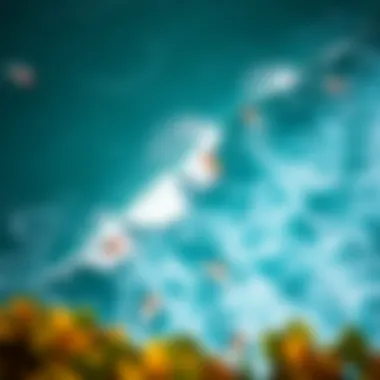
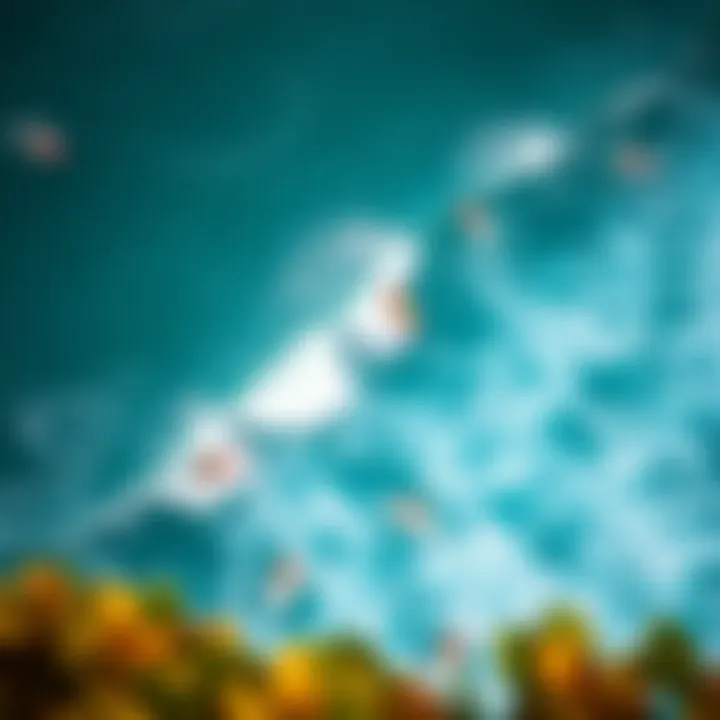
Intro
Oahu, known as "The Gathering Place," is a land where the ocean kisses the shore with a fervor that has captivated surfers from around the world. The island's surf spots are legends in their own right, drawing everyone from the local groms to seasoned pros looking to test their mettle against the Pacific's powerful waves. Each break carries its own stories, shaped not just by conditions but also by the culture that surrounds it, offering those who dare to paddle out a chance to engage with nature in a profound way.
In this exploration, we will delve into the heart of Oahu's surfing scene. From the tempestuous reefs of the North Shore to the mellow waves of Waikiki, there’s a surf spot suitable for every skill level. It's not only about catching the perfect wave; it’s about understanding the rhythm of the ocean, the camaraderie among surfers, and the respect for both the water and the environment.
Knowledge is key for any surfer aiming to make the most of their adventure in these waters. This guide aims to shed light on the essentials, from gear recommendations to the nuances of local surf etiquette. Surfers, paddleboarders, kitesurfers, or any water sports enthusiast will find valuable insights here—preparation, safety, and a deep respect for the ocean flow are essential for an enriching experience.
Let's dive into the essentials that will set you up for success in Oahu's breathtaking surf landscape, ensuring that you not only enjoy but also protect this paradise.
Preamble to Oahu's Surf Scene
Oahu, known as the "Gathering Place," has long been celebrated as a hotbed of surfing culture. It boasts an array of surf spots that cater to surfers of all skill levels, from novices finding their footing to seasoned pros seeking the ultimate thrill. Understanding Oahu's surf scene isn't merely about riding waves; it's a deep dive into a vibrant combination of community, tradition, and the natural environment that shapes this unique island.
Surfers flock to Oahu not just for its iconic beaches, but also for the rich history and culture that's entwined with each crest and trough of the waves. This backdrop forms an essential part of the experience, as knowing the historical context and cultural significance can enhance not only one’s surfing skills but also appreciation for the artistry that surfing embodies.
Historical Context
Surfing in Oahu traces back to ancient Polynesian voyagers, who introduced the sport long before Western influences took hold. These early surfers used wooden boards, often made from local trees, and surfed on calm waters. It was not just a sport but a means to strengthen community ties and demonstrate prowess. The practice evolved through the centuries, with the introduction of new materials and techniques, setting the groundwork for the modern sport we recognize today.
By the early 20th century, Hawaii caught the attention of surfing enthusiasts worldwide, largely due to figures like Duke Kahanamoku. He played a pivotal role in promoting the sport beyond the islands. The surfing culture gained momentum post-World War II, transitioning into a leisure activity enjoyed by many, leading to the commercialization of surfing gear and competitions.
This storied past has laid the foundation for Oahu's reputation as a premier surf destination. Visitors walk on the same sand where surfing legends once carved their paths, all while feeling the pulse of history beneath their feet. With Oahu as a backdrop, surfers become part of something much larger than themselves—a rhythm that has been carried through generations.
Cultural Significance
Oahu’s surf culture is imbued with a sense of respect and connection to nature. It is deeply woven into the fabric of Hawaiian identity. Surfers don’t merely surf; they honor the ocean, its rhythms, and the history that comes with it. Terms such as "Aloha" and "Ohana" represent familial bonds and community respect, principles that permeate the surfing world and influence local interactions.
Modern surfing competitions in places like Waimea Bay and Pipeline celebrate this culture while also drawing global attention. Such events not only showcase talent but also act as reminders of the sport's roots. They invite spectators to become part of a lively tradition that encapsulates everything from camaraderie among surfers to environmental consciousness.
The challenges facing Oahu’s surf environment, such as pollution and climate change, elevate the need for sustainable practices and conservation efforts, highlighting that the ocean isn’t just for sport; it’s an essential life source for many communities.
The North Shore: A Legendary Destination
The North Shore of Oahu isn't just another surf spot; it's a mecca of wave-riding culture with a vibe that leaves an imprint on anyone who sets foot on its golden sands. It's known for its monumental waves and colorful cast of surfers that seem to melt together into a rhythm of adrenaline and saltwater. This area has become synonymous with surfing, pulling in enthusiasts from all walks of life, and this article aims to highlight what makes the North Shore a legendary destination.
Waimea Bay
Best Surf Seasons
The best seasons for surfing at Waimea Bay generally span from November to February, when the winter swells begin to rear their heads. These months are critical for more advanced surfers, as they can expect some of the most intense conditions, which creates an electrifying atmosphere. Waves during this time are known to reach heights of over 30 feet, attracting seasoned surfers eager to tackle these giants.
Waimea’s winter waves are not only a challenge but also a vibrant spectacle that helps shape the surfing culture in this region. Additionally, summer offers smaller waves, making it a welcoming season for beginners and learners, thereby promoting inclusivity in the surf community.
Local Conditions and Hazards
Waimea Bay presents a unique challenge with its sometimes powerful rip currents and shifting sandbars, which can change from one day to another. The bay itself is often influenced by weather patterns and tidal changes, making local knowledge invaluable. Surfers must pay attention to the conditions before hitting the water, and it’s often advised to consult with local surfers for guidance.
Awareness of these hazards means that newcomers can enjoy the waves safely. Consequently, those who visit must approach with both respect and care, as Waimea's beauty can often mask its perilous nature.
Safety Considerations
Safety is paramount when surfing at Waimea Bay. All surfers should be equipped with proper gear, including leashes and possibly helmets, especially when tackling bigger waves. It's beneficial for beginners to take lessons from local instructors who not only teach skills but also emphasize safety standards.
Given the rapidly changing conditions, having a strong awareness of one's own skill level is essential. Diving into the surf without evaluating conditions can lead to dangerous situations.
Pipeline

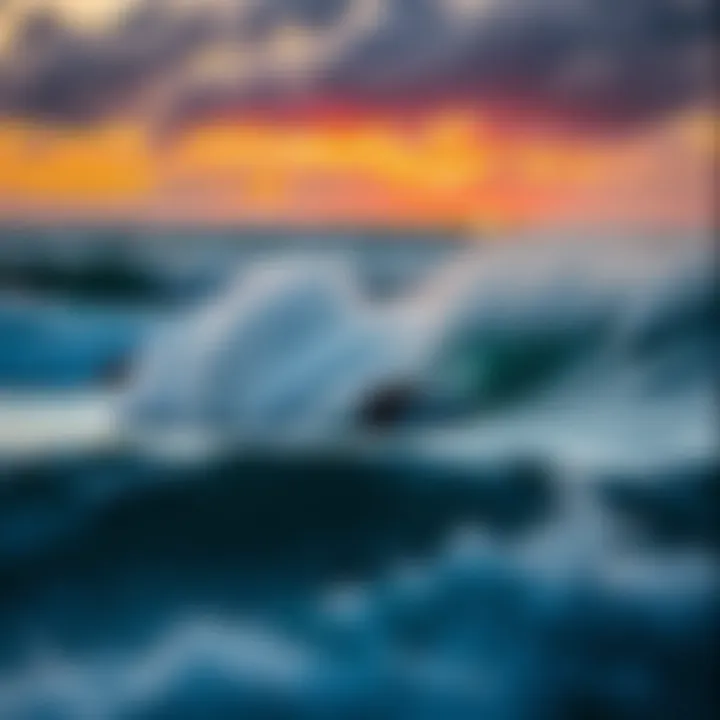
Wave Formation
Pipeline’s waves are known for their perfect barreling shape, formed as they break over a shallow reef. The unique geological setup causes thrilling, powerful barrels that are a sight to behold. Conditions here are highly variable; the famous winter swells create waves that are not only iconic but also intimidating.
The formation of these waves tends to weed out less experienced surfers since they demand precision and respect for the ocean's power. Skilled surfers from around the world flock here to test their mettle against these formidable waves.
Local Rules and Etiquette
Pipeline embodies a rich surfing history, and with that comes ingrained local rules and etiquette. First and foremost, respect the lineup—paddling for waves should be conducted in good faith with an understanding of who has priority. This nuanced culture emphasizes respect, and breaking these unwritten rules can lead to confrontational situations.
For surfers aiming to ride here, understanding the local customs can not only enhance their experience but also serve as a vital acknowledgment of the area’s heritage.
High-Performance Surfing
Pipeline is a stage for high-performance surfing, where elite surfers demonstrate their skills in breathtaking maneuvers. The waves here act almost like a testing ground for techniques and styles, pushing boundaries and encouraging innovation.
However, not all surfers can handle the level of talent seen here; aspiring riders may find the experience both awe-inspiring and intimidating. Those who embrace the challenge can leave with invaluable lessons and unforgettable stories.
Sunset Beach
Wave Characteristics
The waves at Sunset Beach are characterized by their long, rolling swells that offer a range of experiences for varying skill levels. During the winter, the waves pack more power and can stretch to heights similar to those found at Pipeline. However, in summer, conditions shift favorably for novices, with much smaller and more manageable waves.
The variances in wave characteristics are beneficial for those looking to hone their skills or enjoy a more relaxed day on the water. However, understanding these transitions is crucial so surfers can prepare appropriately for different conditions.
Competitions and Events
Sunset Beach is often the venue of choice for major surf competitions, including the Vans Triple Crown of Surfing. These events attract surfers from around the globe, creating a competitive but friendly atmosphere. The thrill of witnessing the best in the business negotiate Sunset's waves is an experience like no other.
Participation in local events undoubtedly strengthens community ties among surfers, offering not just competition but camaraderie, which is essential to the surf culture.
Access and Amenities
Access to Sunset Beach is relatively simple, with ample parking and beach facilities. Nearby shops provide gear rentals and refreshments, catering to a variety of surfers and spectators. The vicinity around the beach has been developed to support surf culture, with food trucks and local establishments that bring the flavors of Hawaii to the surfing experience.
However, it can get busy during peak seasons, and securing a spot on the beach requires some planning. Nevertheless, those making the trip are rewarded with stunning views and exhilarating waves.
The South Shore: Urban Surfing Experience
The South Shore of Oahu stands as a vibrant blend of urban life and remarkable surf. It serves as a magnet for both locals and tourists, making it a crucial element in any exploration of Oahu's surf scene. This area is characterized by its accessible beaches and lively atmosphere, offering something for everyone—from beginners learning to ride the waves to seasoned surfers seeking engaging experiences. The urban backdrop of the South Shore adds layers to its surf culture, making it a unique destination where the thrill of catching waves meets the hustle of city life.
Waikiki Beach
Learning Opportunities for Beginners
Waikiki Beach is renowned for nurturing budding surfers. The gentle slopes and consistent waves create a perfect environment for novices to step onto a board for the first time. The beachfront offers various learning opportunities, including group lessons and private coaching tailored to meet different skill levels.
A key characteristic of this spot is its beginner-friendly surf schools, which have been around for years. They know how to break down the basics effectively, allowing beginners to grasp techniques quickly. A unique feature of learning at Waikiki is how the waves are not only forgiving but also manageable, which helps build confidence from the get-go. However, the beach can get crowded, especially during peak season, which might make it tough for learners who prefer a quieter environment.
Surf Schools and Rentals
The surf schools and rentals along Waikiki Beach are a vital part of the local scene, contributing significantly to its appeal. These establishments provide a wealth of resources and gear, making it convenient for visitors to get involved in the surfing culture without needing to bring their own equipment.
A standout feature of these schools is their attentive instructors, who often personalize lessons based on individual needs. This adaptability leads to a more enriching experience for participants. On the flip side, during busy periods, securing a rental could feel rushed, and availability might be limited, which could pull down the overall experience.
Cultural Attractions Nearby
Waikiki Beach isn't just about surfing; nearby cultural attractions enrich its allure as well. From the historic Royal Hawaiian Hotel to the famous Duke Kahanamoku statue, visitors enjoy a full range of experiences surrounding their surf sessions. These sites reflect Oahu’s history and culture, enhancing the beach experience with meaningful context.
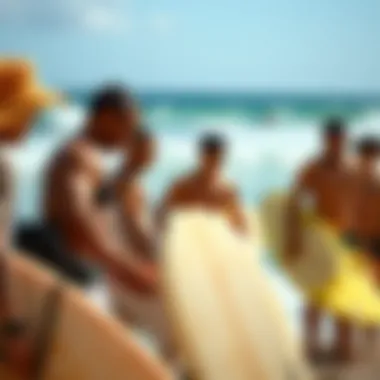
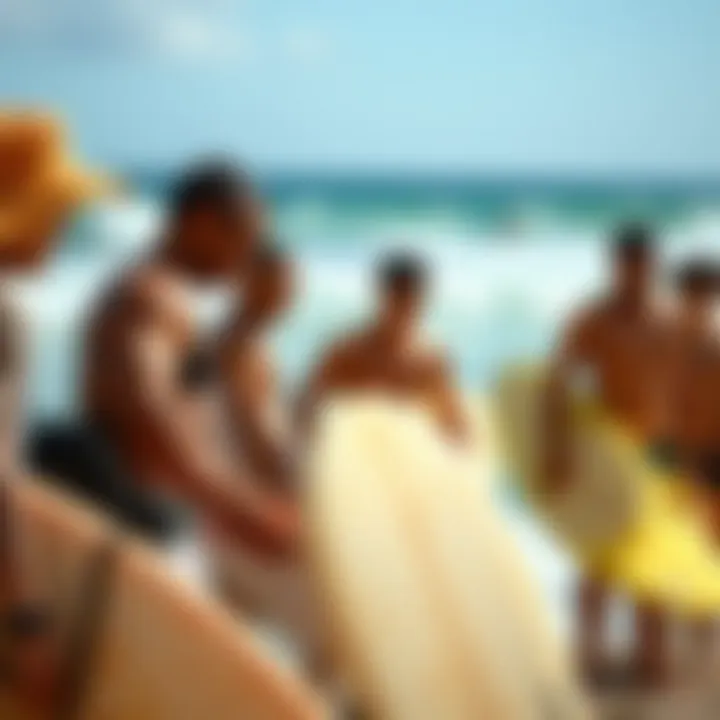
By exploring these attractions, surfers can embrace both the wave riding and cultural tapestry of the area. However, the constant bustle could divert attention from the actual surfing, making some surfers feel like they need to juggle too much at once. But for many, it’s precisely this fusion of activities that creates an unforgettable trip.
Diamond Head
Wave Dynamics
Diamond Head’s waves present a different challenge for surfers. Known for its striking landscape, the reef breaks create quality surf conditions, drawing many to its pristine waters. The dynamics of the waves here are influenced by natural formations which can be both breathtaking and intimidating.
One important characteristic of the Diamond Head waves is their ability to cater to intermediates and advanced surfers, as they can vary significantly in height and strength depending on the season. This variability brings an exhilarating unpredictability to the surf, attracting those looking to push their limits. On the downside, the nature of the waves might not be ideal for beginners, who may find the conditions overwhelming.
Impact of Tourists on Local Surf Culture
As a popular tourist destination, Diamond Head faces the challenge of balancing local surf culture with the influx of visitors. Tourists often flock to the area, seeking to ride its iconic waves, which can create a sense of overcrowding and competition in the water.
A notable feature of this dynamic is the local surfers' ongoing efforts to maintain their culture and prioritize respect among surfers. However, with the growing number of tourists, there's an ongoing dialogue about the preservation of surf etiquette that needs constant reinforcement. Failure to address this can lead to frustrations among locals and newcomers alike, which could tarnish the overall experience.
Best Times to Surf
Understanding the best times to hit the waves at Diamond Head can greatly enhance a surfer’s experience. Typically, the winter months showcase larger swells, appealing to more adventurous riders. Conversely, summers often bring smaller, more manageable waves, making it favorable for learners and those looking for a less intense thrill.
The timing also opens up opportunities to enjoy other aspects of the area, such as hiking trails that provide stunning overhead views of the ocean. However, the variability between seasons can leave surfers wanting if they don’t properly plan their visit. Mapping out ideal times ensures you maximize your surf outings and social experiences alike.
West Coast Gems: Less Known Spots
The west coast of Oahu is a treasure trove of surf spots that often fly under the radar compared to more popular locales like Waikiki. These hidden gems, like Makaha Beach and Ka'ena Point, boast less crowded waves and a unique charm that appeals to both seasoned surfers and those seeking tranquility. Understanding these locations can enrich one’s experience of Oahu’s diverse surf scene, making each session feel like a personal adventure rather than just a routine outing.
Makaha Beach
Popularity Among Locals
One of the main draws of Makaha Beach is its local flavor. This spot is embraced by the island's residents who often gather here for both relaxation and surf. Unlike the tourist-packed areas, Makaha represents a more authentic experience, which resonates deeply with the island’s community vibe. Surfers at Makaha tend to form a close-knit group, sharing waves and tips, maintaining a respectful and friendly atmosphere. This local popularity ensures that surf conditions remain high-quality and vibrant.
Surfing Conditions and Dangers
The surfing conditions at Makaha Beach can be quite dynamic. The swells here can get massive during winter, which attracts experienced surfers. However, with these impressive waves comes a reality check; the currents can shift unexpectedly, presenting dangers that require keen awareness. Beginners should be particularly cautious, as the beach has strong rip currents that can pose a risk. Understanding these conditions can be vital for safety and to get the best from each surf session. Knowing your limits and being mindful of the ocean's power is key here.
Wildlife and Environmental Concerns
The ecological perspective at Makaha Beach is quite significant. The presence of diverse marine life, including sea turtles and various fish species, makes it a spot of interest not just for surfers but for nature lovers. However, increased foot traffic and waste can endanger these populations. This calls for responsible practices, like ensuring trash is picked up, to maintain the health of the local ecosystem. Surfers can really make an impact by participating in community beach clean-ups, working towards sustaining Makaha’s natural beauty and ensuring that wildlife thrives.
Ka'ena Point
Scenic Views
The scenic views at Ka'ena Point are nothing short of breathtaking. Surfers and visitors are treated to expansive vistas of the ocean meeting rocky cliffs, making it a popular site for soft gales and serene sunsets. These visuals not only enhance the surfing experience but also provide moments of reflection and appreciation for the natural world. It’s a reminder that the joys of surfing extend beyond the waves themselves; the surroundings play a significant role in the overall experience. This spot is exceptionally breathtaking at dawn, when the sun rises above the horizon and bathes everything in a golden hue.
Isolation and Accessibility
Ka'ena Point offers a sense of solitude that cannot be found in more mainstream surf spots. Its somewhat remote location makes it less frequented, fulfilling the desires of surfers seeking unspoiled waves and tranquility. Getting to Ka'ena Point requires a bit of effort, often involving a hike that pushes some would-be surfers away. However, the adventure to reach this beautiful area is part of its charm, drawing in those who are willing to make the trek for the sake of pristine conditions and a relaxed atmosphere. This isolation offers a unique opportunity to connect more directly with the ocean and nature itself.
Environmental Preservation
At Ka'ena Point, the focus on environmental preservation is crucial. This area is part of a natural reserve, emphasizing the need for surfers to act as stewards of the land and sea. Taking care of this beautiful enclave involves adhering to specific regulations aimed at protecting local wildlife and habitats. Surfers can contribute by considering their actions, from minimizing waste to choosing eco-friendly products. Engaging in local conservation efforts helps ensure that this stunning locale remains untouched for generations to come, enriching the experience of those who come to ride the waves.
By exploring these less known spots, surfers not only enrich their own experiences but also contribute to the preservation of Oahu's surfing culture.
These less popular but equally captivating spots on Oahu's west coast offer surf enthusiasts a chance to enjoy the ocean while connecting with the local environment. Whether it's the community spirit at Makaha Beach or the breathtaking views at Ka'ena Point, these locales emphasize the diversity and beauty of Oahu's surfing landscape.
Malama the Ocean: Environmental Awareness
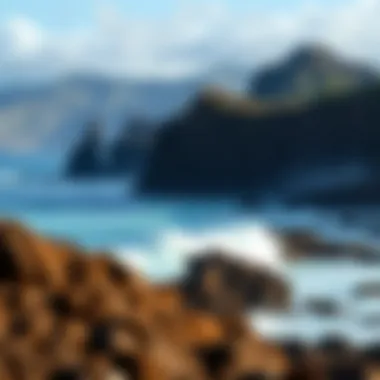
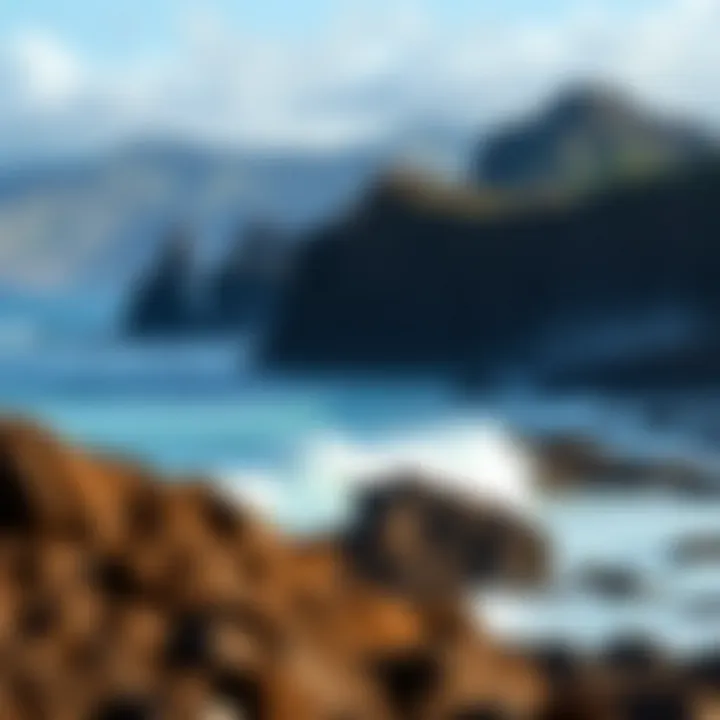
Understanding the responsibility that comes with surf culture on Oahu is essential. Malama means to care for and protect, and this philosophy applies to the ocean as much as to the land. From novice surfers to are pros, taking care of the environment should be a top priority. Surfers have a unique relationship with the ocean; they feel its rhythms, witness its beauty, and must recognize their role in its preservation. By practicing better environmental awareness, surfers can ensure that future generations can continue to enjoy the waves.
Responsible Surfing Practices
Cleaning Up Beaches
Cleaning up beaches is a fundamental aspect of responsible surfing. When surfers take time to remove trash, it benefits both the local ecosystem and the community. Not only does it keep the beaches beautiful, but it also prevents debris from harming marine wildlife. An interesting characteristic of this practice is its community-driven nature. When surfers gather for a cleanup, they bond over their love for the ocean, celebrating the place they cherish. Surfing does not just happen on the water but also extends to keeping the shorelines pristine. However, it can be challenging to get enough people involved consistently. The unique feature of organizing a cleanup is that local surf shops often offer incentives like discounted rentals or surf lessons to encourage participation. This builds a sense of shared responsibility while fostering a community spirit.
Statistics on Surf-Related Pollution
Pollution is a potent issue, and surf-related pollution sheds light on how surf culture can impact the environment. For instance, studies have found that microplastics are increasingly present in ocean waters around popular surf spots. A notable statistic is that 80% of ocean pollution comes from land sources, which emphasizes the importance of rethinking our waste disposal practices. This statistic resonates deeply within the surfing community as it highlights both the problem and the role surfers can play in combatting it. Surfers can advocate for better waste management practices and support initiatives that reduce pollution. On the downside, it can be disheartening to relate to such data; however, recognizing these statistics can spur action and prioritize solutions to improve the environment.
Importance of Wildlife Conservation
Protecting marine life is vital for maintaining a balanced ecosystem where everyone can thrive. Effective conservation efforts ensure that fish populations remain healthy, which in turn allows for better surf conditions. A significant characteristic of wildlife conservation is the emphasis on the biodiversity of marine species, which helps maintain the ocean's health. This can resonate with surfers who depend on the stability of ocean ecosystems. A unique aspect is how surfers can directly contribute through organizations like Surfrider Foundation which works tirelessly in protecting coastlines. The advantage of engaging in such conservation initiatives is that it elevates the overall experience of surfing, making it more meaningful. Neglecting this aspect will only isolate surfers from the richness of the ocean's environment.
Supporting Local Initiatives
Community Programs
Community programs that focus on environmental stewardship offer a powerful way for surfers to engage. These initiatives often involve educational activities, beach cleanups, and workshops that stress the importance of caring for the ocean. A notable characteristic of many such programs is their grassroots nature, which provides local surfers a platform to voice their concerns. Supporting these programs strengthens community ties and increases the overall effectiveness of conservation efforts. However, they require ongoing participation and funding to sustain operations. The unique feature of these programs is that they can often be tailored to local issues, providing specific solutions that resonate with community members directly.
Collaboration with Local Organizations
Teaming up with local organizations lends credence to surfers’ efforts to help their environment. By collaborating, surfers can access resources and expertise that bolster their initiatives. These partnerships often foster public awareness campaigns, further amplifying their reach to the community. One key characteristic of these collaborations is that they can leverage both environmental and social issues, creating a more comprehensive impact. A downside could be the complexity involved in coordinating between multiple entities, as interests sometimes diverge. However, the benefits outweigh these hurdles when there are clear shared goals. The ability to pool resources often leads to more effective conservation strategies that would be hard to implement independently.
Creating Awareness Among Surfers
Raising awareness among surfers is crucial to fostering an ethics-driven surfing culture. This involves informing surfers about environmental issues and encouraging them to become advocates for the ocean. Educational campaigns can outline the simple steps anyone can take to support the environment. A vital characteristic of these campaigns is their ability to engage surfers through relatable storytelling and experiences. For instance, sharing real-life impacts of pollution visualization can strike a chord. However, drawing attention to these issues can sometimes come off as overwhelming. The unique aspect of awareness initiatives is their adaptability; they can evolve based on ongoing scientific findings, ensuring that the information remains relevant and actionable. As more surfers recognize their power as environmental stewards, the impact they can make only grows.
Final Thoughts
As we reach the tail end of our exploration into Oahu's premier surf spots, it’s crucial to take a moment to reflect on the multifaceted experiences that the island offers to surfers, regardless of their skill level. The comprehensive insight provided throughout this article highlights not just the thrill of riding waves but the profound connection surfers have with the ocean. The culture, the community, and the responsibility towards the environment all intertwine, shaping a holistic surfing experience.
Surfing in Oahu is more than just a sport; it’s an expression of life and resilience. For many, the waves of the North Shore or the gentle swells of Waikiki become a second home. Understanding this dynamic is fundamental. Surfers gain much by immersing themselves in the local culture while respecting the ocean's power. Each surf location offers unique advantages, from the breathtaking beauty of Pipeline to the serene experience of Ka'ena Point, reminding us that every surfer can find their niche.
Consider these key points when venturing into Oahu's water:
- Safety First: Always prioritize safety by monitoring the conditions and being aware of local hazards.
- Embrace Local Etiquette: Following the unspoken rules of the lineup fosters camaraderie and respect, essential to local surf culture.
- Be Environmentally Conscious: Simple actions like cleaning up after oneself can contribute greatly to preserving the beauty of these spots for future generations.
"Surfing at its best harmonizes with nature, making every ride a dance between man and the sea."
In this way, surfers become stewards of the ocean, creating a legacy that supports local ecosystems and inspires the sharing of wisdom among peers.
The joy of surfing does not lie solely in catching a wave, but in the stories shared, the laughter echoed, and the challenges faced, reminding us that every surf session adds a new chapter to our life’s journey. As you embark on your own surfing adventures across Oahu’s stunning beaches, remember that gathering experiences is fundamental, not just for mastering the craft but for connecting with its soul.
Gathering Experiences
Experiencing the diverse surf spots of Oahu goes beyond merely riding the waves. It involves immersing yourself in the local culture, making connections, and gathering stories. Each surf session holds the potential for growth, adventure, and personal reflection.
Here’s how to maximize this journey:
- Listen to Local Surfers: Understanding the nuances of each surf break from experienced locals can provide invaluable insights.
- Document Your Experiences: Keeping a surf journal can enhance your learning and allow you to track progress and changes in local conditions.
- Engage with the Community: Participating in local events or discussions can deepen your appreciation of the culture surrounding the surfing lifestyle.
All of these activities will help enrich your surfing experience, turning every wave ridden into a treasured memory.
Embracing Surf Culture
Oahu's surf culture is vibrant and diverse, encompassing not just those who surf but a broader community that includes families, artists, and environmentalists. It’s impossible to separate the act of surfing from the cultural tapestry that surrounds it. By embracing this culture, surfers not only enhance their own experience but also contribute to the collective identity of the island.
The surf culture in Oahu encourages surfers to embrace the rhythm of the ocean while fostering respect for the land and sea. Here are a few ways to immerse yourself in this rich culture:
- Participate in Beach Clean-Ups: Engaging in community-led efforts to keep the ocean clean shows commitment to sustainability.
- Learn About Hawaiian History: Understanding traditional Hawaiian practices and the significance of surfing in their culture can deepen your connection to the sport.
- Share Your Passion: Whether through teaching others or engaging in discussions, spreading the love for surfing helps keep the spirit alive.
As surfers, whether seasoned or novice, we collectively lay the groundwork for a culture steeped in respect, passion, and responsibility. Embracing the surfing ethos can create lasting impacts, reinforcing the bond between surfers and the vibrant waters of Oahu.



